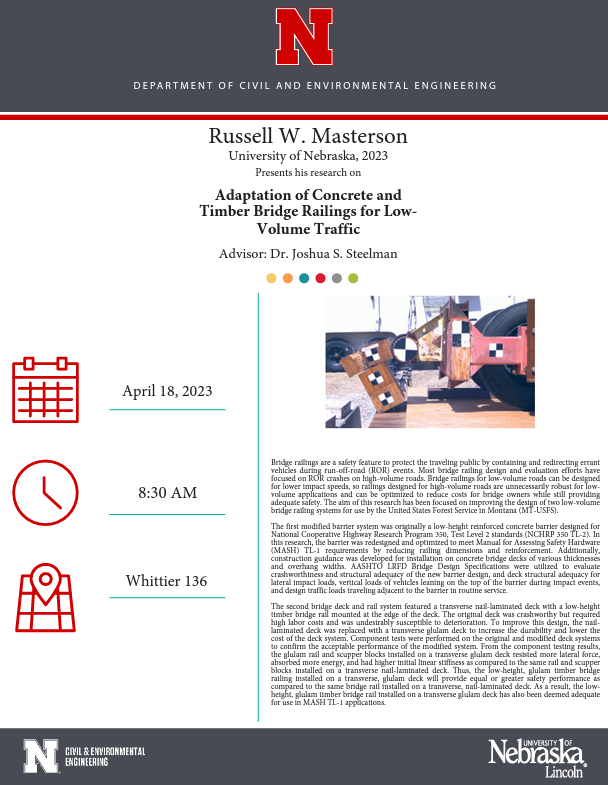
Russell W. Masterson
University of Nebraska, 2023
Presents his research on Adaptation of Concrete and Timber Bridge Railings for Low-Volume Traffic
Advisor: Dr. Joshua S. Steelman
April 18, 2023
8:30 AM
Whittier 136
Bridge railings are a safety feature to protect the traveling public by containing and redirecting errant vehicles during run-off-road (ROR) events. Most bridge railing design and evaluation efforts have focused on ROR crashes on high-volume roads. Bridge railings for low-volume roads can be designed for lower impact speeds, so railings designed for high-volume roads are unnecessarily robust for lowvolume applications and can be optimized to reduce costs for bridge owners while still providing adequate safety. The aim of this research has been focused on improving the design of two low-volume bridge railing systems for use by the United States Forest Service in Montana (MT-USFS).
The first modified barrier system was originally a low-height reinforced concrete barrier designed for National Cooperative Highway Research Program 350, Test Level 2 standards (NCHRP 350 TL-2). In this research, the barrier was redesigned and optimized to meet Manual for Assessing Safety Hardware (MASH) TL-1 requirements by reducing railing dimensions and reinforcement. Additionally, construction guidance was developed for installation on concrete bridge decks of various thicknesses and overhang widths. AASHTO LRFD Bridge Design Specifications were utilized to evaluate crashworthiness and structural adequacy of the new barrier design, and deck structural adequacy for lateral impact loads, vertical loads of vehicles leaning on the top of the barrier during impact events, and design traffic loads traveling adjacent to the barrier in routine service.
The second bridge deck and rail system featured a transverse nail-laminated deck with a low-height timber bridge rail mounted at the edge of the deck. The original deck was crashworthy but required high labor costs and was undesirably susceptible to deterioration. To improve this design, the naillaminated deck was replaced with a transverse glulam deck to increase the durability and lower the cost of the deck system. Component tests were performed on the original and modified deck systems to confirm the acceptable performance of the modified system. From the component testing results, the glulam rail and scupper blocks installed on a transverse glulam deck resisted more lateral force, absorbed more energy, and had higher initial linear stiffness as compared to the same rail and scupper blocks installed on a transverse nail-laminated deck. Thus, the low-height, glulam timber bridge railing installed on a transverse, glulam deck will provide equal or greater safety performance as compared to the same bridge rail installed on a transverse, nail-laminated deck. As a result, the lowheight, glulam timber bridge rail installed on a transverse glulam deck has also been deemed adequate for use in MASH TL-1 applications.